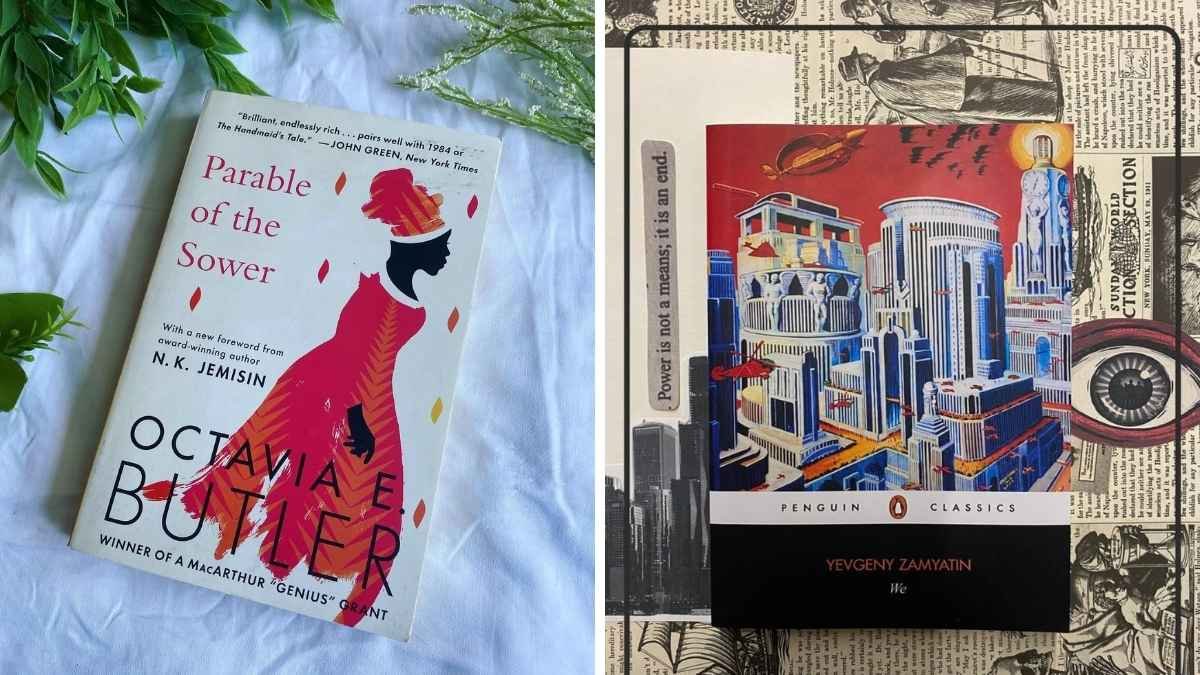
History isn’t just dates, battles, and dusty old kings. It’s a living, breathing story that shapes how we see ourselves and the world.
But what if everything you learned in school was… incomplete? What if the past was stranger, wilder, and more complex than any textbook could capture?
These 14 books aren’t just history—they’re revolutions. They’ll flip your assumptions, challenge your beliefs, and leave you wondering: What else don’t I know? Let’s dive into the first five.
1. “Guns, Germs, and Steel” by Jared Diamond

If you’ve ever wondered why some civilizations conquered and others were conquered, this book is your wake-up call. Jared Diamond argues that geography, not genetics, environment gifted them with domesticatable animals, grain crops, and east-west trade routes that spread technology faster than you can say “potato.” Meanwhile, societies in Africa and the Americas were held back not by laziness, but by a lack of draft animals and killer pathogens (thanks, smallpox). Diamond’s thesis is bold, but it’s backed by science—and it’ll make you question every “superiority” narrative you’ve ever heard.
But here’s the kicker: Diamond isn’t just rewriting history; he’s warning us. The same environmental factors that built empires could just as easily collapse them if we ignore the planet’s limits. Think history is just “old stuff”? Think again.
2. “Sapiens: A Brief History of Humankind” by Yuval Noah Harari

Yuval Harari’s masterpiece is the ultimate brain trip. He argues that what makes humans special isn’t our brains or opposable thumbs—it’s our ability to believe in shared fiction. Money, nations, religions, human rights—none of these exist in nature. They’re collective myths that we all agree to treat as real. Without them, you’d never get seven billion strangers to cooperate.
Harari’s real genius is how he connects ancient history to today. He’ll make you see capitalism as a religion, empires as data-collection projects, and modern technology as a threat to our very humanity. By the end, you’ll wonder: Are we running the show, or are we just actors in a play written by our delusions?
3. “1491: New Revelations of the Americas Before Columbus” by Charles C. Mann

Everything you know about pre-Columbian America is wrong. Charles Mann reveals that the “pristine wilderness” Europeans “discovered” was a carefully managed garden tended by advanced civilizations. The Amazon? Not a virgin rainforest, but a human-created ecosystem. The Great Plains? Managed by Indigenous fire techniques that shaped the entire landscape.
Mann’s research is jaw-dropping. He shows how genocide by disease (not “primitive” societies) cleared the land for colonization, and how Indigenous innovations—from Three Sisters farming to incredible water management systems—were stolen, ignored, or destroyed. This book isn’t just about the past; it’s a call to recognize and learn from the world’s first environmentalists.
4. “The Warmth of Other Suns” by Isabel Wilkerson

History books often treat the Great Migration as a footnote. Isabel Wilkerson makes it an epic. Through the stories of three ordinary people—a sharecropper, a doctor, and a laborer—she reveals how six million Black Americans fled the terror of the Jim Crow South for the illusion of freedom in the North. Their journey wasn’t just about escaping lynching; it was about refusing to be invisible.
Wilkerson’s research is staggering, but what makes this book unforgettable is her humanity. She’ll make you feel the weight of a suitcase, the cold of Chicago winters, and the bitter irony of trading one kind of oppression for another. By the end, you’ll see migration not as a political issue, but as the oldest human story there is: the quest for dignity.
5. “The Silk Roads: A New History of the World” by Peter Frankopan

Ever wondered why history focuses so much on Europe? Peter Frankopan has a simple answer: it’s Eurocentric nonsense. His book shifts the spotlight to the Silk Roads, the ancient networks that connected East and West long before Columbus was a glint in his father’s eye. Here, you’ll meet Persian poets, Arab scientists, and Chinese emperors who shaped the world while Europe was… well, kind of a backwater.
Frankopan’s big idea is that power follows trade routes. When the Silk Roads thrived, so did knowledge, religion, and empires. When did they collapse? Chaos ensued. Today, as China rebuilds those roads through its Belt and Road Initiative, Frankopan’s warning is clear: Ignore the East at your peril. History isn’t over—it’s just taking a different path.
6. “The Black Death: A Captivating Guide to the Most Pandemic in Human History” by Charles River Editors

The Black Death wasn’t just a footnote in medieval history—it was a civilizational reset button. This book peels back the layers of myth to reveal how the plague killed not just bodies, but entire social orders. Serfdom crumbled, laborers demanded wages, and Europe’s rigid hierarchy was cracked open like an egg. The Church, once unassailable, suddenly seemed… fallible.
But here’s the twist: The plague wasn’t all bad. It sparked innovation, from better sanitation to new economic models. And in the East, where the pandemic started, it reshaped trade routes and empires in ways that Europe would only feel centuries later. This book isn’t just about death—it’s about how catastrophe can birth revolution.
7. “1434: The Year a Magnificent Chinese Fleet Sailed to Italy and Ignited the Renaissance” by Gavin Menzies

What if the Renaissance wasn’t a purely European miracle, but a Chinese spark? Gavin Menzies’ controversial thesis suggests that a Ming fleet reached Italy in 1434, sharing compass technology, printing methods, and astronomical charts with a hungry Europe. Suddenly, Brunelleschi’s dome, Gutenberg’s press, and Columbus’s voyages start to look less like “genius” and more like borrowed brilliance.
Love it or hate it, Menzies’ book forces you to ask: What if history is just a game of telephone, where ideas get whispered from one culture to another, often with the original sender forgotten? Even if his evidence is debated, the idea is too juicy to ignore—and it’ll make you wonder what other “original” ideas might have ancient roots.
8. “The History of White People” by Nell Irvin Painter

Race isn’t a fact—it’s a fiction with teeth. Nell Irvin Painter’s groundbreaking work traces how the concept of “whiteness” was invented, not in ancient times, but during the American colonial era. Originally, only Northern Europeans qualified; Italians, Irish, and Jews had to earn their whiteness over centuries. Sound familiar? It’s the same process that created “Blackness” and “Asian-ness” as political tools.
Painter’s real genius is showing how race was built to serve power, not biology. By the 19th century, “white people” were a unified club, complete with membership perks like land ownership and voting rights. This book isn’t just history—it’s a survival guide for understanding how identity is weaponized.
9. “The Better Angels of Our Nature: Why Violence Has Declined” by Steven Pinker

History is a bloodstained tapestry, but what if we’re getting less brutal? Steven Pinker’s data-driven masterpiece argues that violence—war, murder, torture—has declined dramatically over millennia. The Stone Age was a free-for-all slaughter, medieval Europe was a carnival of cruelty, and even World War II looks like a blip when graphed against the global population.
Pinker’s “civilizing forces”—trade, democracy, literacy, and (yes) feminism—are the unsung heroes of this story. But don’t get too cozy: He’ll also remind you that violence never really leaves; it just evolves into subtler forms. Think cyberwar, propaganda, and drone strikes. Progress? Maybe. But it’s a progress with an asterisk.
10. “The Dawn of Everything: A New History of Humanity” by David Graeber and David Wengrow

Forget the “inevitable march of progress.” Graeber and Wengrow’s final collaboration is a rebellion against the idea that history had to unfold the way it did. They show how ancient societies experimented with egalitarianism, hierarchy, and everything in between, often switching modes like outfits. The Maya had ritual kingships that lasted a single festival; the Inuit practiced democracy in the coldest places on Earth.
The authors’ biggest bombshell? The idea that “civilization” wasn’t a package deal. Some societies had cities but no states; others had states but no cities. And hunter-gatherers? Many lived better, longer, and more freely than their “advanced” neighbors. This book is a permission slip to imagine a different past—and a different future.
11. “Bury My Heart at Wounded Knee: An Indian History of the American West” by Dee Brown

The American West wasn’t won—it was stolen. Dee Brown’s masterpiece tells the story of the Indigenous peoples who were systematically erased from their land. Using council records and firsthand accounts, Brown reveals how the US government’s “Manifest Destiny” was built on broken treaties, massacres, and cultural genocide. The Lakota, Cheyenne, and Apache didn’t just lose battles—they lost their entire way of life.
But Brown’s genius is in the details. He’ll make you feel the weight of a buffalo robe, the scent of sage at a sacred ceremony, and the hollow victory of Wounded Knee. This book isn’t just history—it’s a call to grief and accountability.
12. “A People’s History of the United States” by Howard Zinn

What if history wasn’t written by the winners, but by the people who fought the winners? Howard Zinn flips the script by telling America’s story through the eyes of slaves, workers, women, and immigrants. The Founding Fathers? Not so noble when you’re talking about stolen land and unpaid labor. The “Greatest Generation”? Less heroic when you consider how many poor soldiers died in the rich men’s wars.
Zinn’s book is a blueprint for resistance. He shows how everyday people—striking in factories, marching for voting rights, or refusing to board segregated buses—have always been the real engine of change. History isn’t just something that happens to us; it’s something we make. And Zinn’s reminder is clear: Don’t wait for heroes—be the hero.
13. “The Devil in the White City: A Saga of Magic and Murder at the Fair That Changed America” by Erik Larson

Step into the glamorous chaos of the 1893 World’s Columbian Exposition in Chicago—a city within a city, built in just 26 months. Architects, engineers, and artists raced to create the “White City”, a utopian vision of the future. But lurking in the shadows was H.H. Holmes, America’s first serial killer, who used the fair to lure victims to his “Murder Castle”.
Larson’s genius is in how he weaves these two stories together. The fair represents human ambition and collaboration, while Holmes embodies the darkness that ambition can hide. By the end, you’ll see that history isn’t just about progress—it’s about the monsters we build alongside it.
14. “Open Veins of Latin America: Five Centuries of the Pillage of a Continent” by Eduardo Galeano

Latin America’s history is a story of exploitation—and resistance. Galeano’s poetic yet furious account traces how European colonizers and later American corporations bled the continent dry, from silver mines to banana plantations. The people? Treated as disposable labor in the name of “development.”
But Galeano doesn’t stop at anger. He celebrates the resilience of Indigenous and Afro-Latinx communities, who survived slavery, coups, and ecological destruction. His message is clear: The past isn’t just a tragedy—it’s a blueprint for survival. Today’s fights for land, dignity, and sovereignty? They’re the same fights, just newer. And Galeano’s book is a battle cry to remember that.






